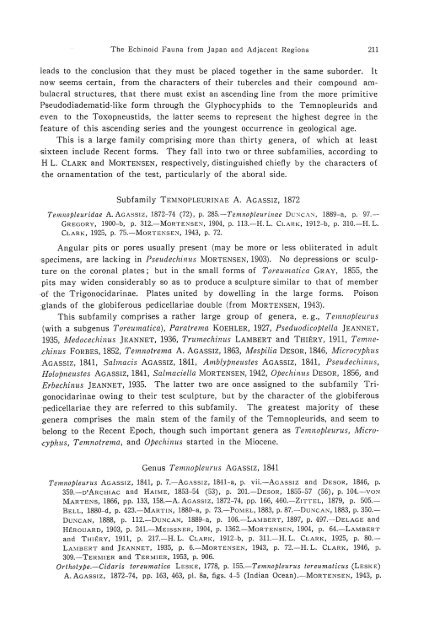the echinoid fauna from japan and adjacent regions part i
the echinoid fauna from japan and adjacent regions part i
the echinoid fauna from japan and adjacent regions part i
Create successful ePaper yourself
Turn your PDF publications into a flip-book with our unique Google optimized e-Paper software.
The Echinoid Fauna <strong>from</strong> Japan <strong>and</strong> Adjacent Regions 211<br />
leads to <strong>the</strong> conclusion that <strong>the</strong>y must be placed toge<strong>the</strong>r in <strong>the</strong> same suborder. It<br />
now seems certain, <strong>from</strong> <strong>the</strong> characters of <strong>the</strong>ir tubercles <strong>and</strong> <strong>the</strong>ir compound ambulacral<br />
structures, that <strong>the</strong>re must exist an ascending line <strong>from</strong> <strong>the</strong> more primitive<br />
Pseudodiadematid-like form through <strong>the</strong> Glyphocyphids to <strong>the</strong> Temnopleurids <strong>and</strong><br />
even to <strong>the</strong> Toxopneustids, <strong>the</strong> latter seems to represent <strong>the</strong> highest degree in <strong>the</strong><br />
feature of this ascending series <strong>and</strong> <strong>the</strong> youngest occurrence in geological age.<br />
This is a large family comprising more than thirty genera, of which at least<br />
:sixteen include Recent forms. They fall into two or three subfamilies, according to<br />
H L. CLARK <strong>and</strong> MORTENSEN, respectively, distinguished chiefly by <strong>the</strong> characters of<br />
<strong>the</strong> ornamentation of <strong>the</strong> test, <strong>part</strong>icularly of <strong>the</strong> aboral side.<br />
Subfamily TEMNOPLEURINAE A. AGASSIZ, 1872<br />
Temnopleuridae A. AGASSIZ, 1872-74 (72), p. 285.-Temnopleurinae DU:-1CA:-1, 1889-a, p. 97.<br />
GREGORY, 1900-b, p. 312.-MoRTENSEN, 1904, p. 113.-H. L. CLARK, 1912-b, p. 310.-H. L.<br />
CLARK, 1925, p. 75.-MoRTENSE:-1, 1943, p. 72.<br />
Angular pits or pores usually present (may be more or less obliterated in adult<br />
:specimens, are lacking in Pseudechinus MORTENSEN, 1903). No depressions or sculpture<br />
on <strong>the</strong> coronal plates; but in <strong>the</strong> small forms of Toreumatica GRAY, 1855, <strong>the</strong><br />
'pits may widen considerably so as to produce a sculpture similar to that of member<br />
·of <strong>the</strong> Trigonocidarinae. Plates united by dowelling in <strong>the</strong> large forms. Poison<br />
:gl<strong>and</strong>s of <strong>the</strong> globiferous pedicellariae double (<strong>from</strong> MORTENSEN, 1943).<br />
This subfamily comprises a ra<strong>the</strong>r large group of genera, e. g., Temnopleurus<br />
(with a subgenus Toreumatica), Paratrema KOEHLER, 1927, Pseduodicoptella JEANNET,<br />
1935, Medocechinus JEANNET, 1936, Trumechinus LAMBERT <strong>and</strong> THIERY, 1911, Temne<br />
,chinus FORBES, 1852, Temnotrema A. AGASSIZ, 1863, Mespilia DESOR, 1846, Microcyphus<br />
AGASSIZ, 1841, Salmacis AGASSIZ, 1841, Amblypneustes AGASSIZ, 1841, Pseudechinus,<br />
Holopneustes AGASSIZ, 1841, Salmaciella MORTENSEN, 1942, OPechinus DESOR, 1856, <strong>and</strong><br />
Erbechinus JEANNET, 1935. The latter two are once assigned to <strong>the</strong> subfamily Trigonocidarinae<br />
owing to <strong>the</strong>ir test sculpture, but by <strong>the</strong> character of <strong>the</strong> globiferous<br />
-pedicellariae <strong>the</strong>y are referred to this subfamily. The greatest majority of <strong>the</strong>se<br />
'genera comprises <strong>the</strong> main stem of <strong>the</strong> family of <strong>the</strong> Temnopleurids, <strong>and</strong> seem to<br />
'belong to <strong>the</strong> Recent Epoch, though such important genera as Temnopleurus, Micro<br />
.cyphus, Temnotrema, <strong>and</strong> OPechinus started in <strong>the</strong> Miocene.<br />
Genus Temnopleurus AGASSIZ, 1841<br />
Temnopleurus AGASSIZ, 1841, p. 7.-AGASSIZ, 1841-a, p. vii.-AGASSIZ <strong>and</strong> DESOR, 1846, p.<br />
359.-D'ARCHIAC <strong>and</strong> HAIME, 1853-54 (53), p. 201.-DESOR, 1855-57 (56), p. 104.-vON<br />
MARTENS, 1866, pp. 133, 158.-A. AGASSIZ, 1872-74, pp. 166, 460.-ZITTEL, 1879, p. 505.<br />
BELL, 1880-d, p. 423.-MARTIN, 1880-a, p. 73.-POMEL, 1883, p. 87.-DuNCAN, 1883, p. 350.<br />
DUNCAN, 1888, p. 112.-DuNCAN, 1889-a, p. 106.-LAMBERT, 1897, p. 497.-DELAGE <strong>and</strong><br />
HEROUARD, 1903, p. 24I.-MElssNER, 1904, p. 1362.-MoRTENSEN, 1904, p. 64.-LAMBERT<br />
<strong>and</strong> THIERY, 1911, p. 217.-H. L. CLARK, 1912-b, p. 31I.-H. L. CLARK, 1925, p. 80.<br />
LAMBERT <strong>and</strong> JEANNET, 1935, p. 6.-MoRTENSEN, 1943, p. 72.-H. L. CLARK, 1946, p.<br />
309.-TERMIER <strong>and</strong> TERMIER, 1953, p. 906.<br />
Orthotype.-Cidaris toreumatica LESKE, 1778, p. 155.-Temnopleurus toreumaticus (LESKE)<br />
A. AGASSIZ, 1872-74, pp. 163, 463, pI. 8a, figs. 4-5 (Indian Ocean).-MoRTENSEN, 1943, p.












